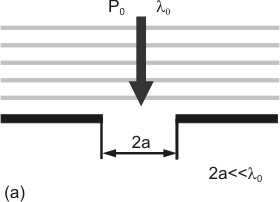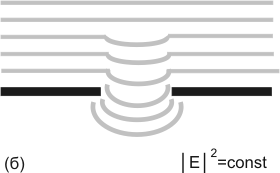3.3 Scanning Near-Field Optical Microscopy
Traditional methods of obtaining optical images of objects have significant restrictions caused by the diffraction of light. One of the fundamental principles of optics is the existence of so-called diffraction limit, which determines the minimum size
 of the object that can be imaged by the optical system for the light with the wavelength
of the object that can be imaged by the optical system for the light with the wavelength
 :
:

(1)
where
 – is the refraction index. In the visual range the limiting size is of the order of 200–300 нм.
– is the refraction index. In the visual range the limiting size is of the order of 200–300 нм.
The Near-Field Optical Microscopy uses other principles of object imaging that allow overcoming the limitations caused by the diffraction of light and provide the spatial resolution of the order of 10 nm or better. Near-field Optical Microscope (NSOM) was invented by Dither Pohl (IBM Zurich Research Laboratory) in 1982, immediately after the invention of tunneling microscope. The operation of this device is based on the propagation of light through sub-wavelength aperture (aperture with the diameter less than the wavelength of incident light).

Fig. 1a. Propagation of light through the
sub-wavelength aperture in the screen.

Fig. 1b. Lines of constant intensity of optical radiation near the
sub-wavelength aperture.
The propagation of light through sub-wavelength aperture has some special features [1, 2]. Electromagnetic field in the diaphragm area has a complex structure. Directly behind the aperture, on the distance
 is located so-called near-field region ,where electromagnetic field exists mainly in the form of evanescent (non-propagating) modes that are localized near the surface of diagram. On the distance
is located so-called near-field region ,where electromagnetic field exists mainly in the form of evanescent (non-propagating) modes that are localized near the surface of diagram. On the distance
 is located far-field region , where only radiation modes are observed. For the light passing through sub-wavelength diaphragm the power of radiation in the far-field region can be estimated by [1]:
is located far-field region , where only radiation modes are observed. For the light passing through sub-wavelength diaphragm the power of radiation in the far-field region can be estimated by [1]:

(2)
where
 – wave vector,
– wave vector,
 – power density of incident light.
– power density of incident light.
It can be shown that for the wavelength of the order of 500 nm and diaphragm with the aperture ~ 5 nm power of the radiation in the far-field region has a level approximately equal to 10–10 of the power of incident radiation. Therefore, at first glance, it seems that application of small apertures for acquisition of raster optical images of the samples is almost impossible. However, if you place the sample directly behind the aperture, in the near-field region, interaction of evanescent modes with the sample causes some part of electromagnetic field energy to be converted into radiation modes that can be measured by the optical photodetector.
Therefore, the near-field image of the object is obtained in the process of scanning of the sample by diaphragm with the sub-wavelength aperture with the result being the distribution of optical radiation intensity
 as a function of the diaphragm position. The contrast of the near-field images is determined by the processes of reflection, refraction, absorption and scattering of light, which in turn depend on the local optical properties of the sample [3].
as a function of the diaphragm position. The contrast of the near-field images is determined by the processes of reflection, refraction, absorption and scattering of light, which in turn depend on the local optical properties of the sample [3].
Summary.
- Near-filed image is acquired in the process of scanning of the sample under test by the diaphragm with sub-wavelength aperture with the result being the distribution of optical radiation intensity as a function of the diagram position.
References.
- D.W.Pohl, W.Denk, M.Lanz, Appl. Phys. Lett., v. 44, p. 651–653 (1984).
- U.Durig, D.W.Pohl, F.Rohrer, J.Appl. Phys. 59 (10) 3318–3327, 1986
- В.Л. Миронов – Основы сканирующей зондовой микроскопии // РАН Институт физики микроструктур, Нижний Новгород, 2004.






